Contemporary Church History Quarterly
Volume 30, Number 4 (Winter 2024)
Review Article: Tim Lorentzen, Bonhoeffers Widerstand im Gedächtnis der Nachwelt. (Paderborn: Brill Schöningh, 2023). Illustrations. ISBN 978-3-506-70473-3.
By Victoria J. Barnett, General Editor, Dietrich Bonhoeffer Works English edition, and former director, Programs on Ethics, Religion, and the Holocaust, U. S. Holocaust Memorial Museum.[i]
This fall a new film about the German theologian/resistance figure Dietrich Bonhoeffer has revived debates among Christians about his legacy and its relevance for contemporary issues. The film, Bonhoeffer: Pastor. Spy. Assassin, provoked protests (in which I was involved) from German and North American scholars in the Bonhoeffer Society and eighty-six members of the extended Bonhoeffer family, as well as disclaimers about the film’s marketing by the German actors and the film’s director. Like most films on Bonhoeffer, the new production plays fast and loose with the historical facts. Readers of this journal will be surprised, for example, to see Martin Niemoeller preaching a rousing sermon in defense of German Jews after Kristallnacht and Winston Churchill appreciatively reading excerpts from Bonhoeffer’s 1933 essay, “The Church and the Jewish Question.” Most protests focused on the film’s portrayal of Bonhoeffer’s resistance as a militant embrace of violence in the name of a just cause: a stunning misrepresentation of Bonhoeffer’s theology and, at a time of rising political violence and Christian Nationalism in the United States, a potentially dangerous one.
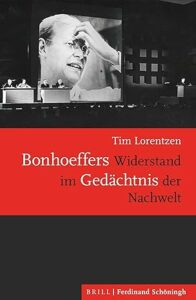 But as Tim Lorentzen’s new book illustrates, it is hardly the first time that interpretations of Bonhoeffer have been based on his ties to the German resistance. Lorentzen, Professor of Early Modern Church History at Kiel University, traces the chronology of German cultural narratives about Bonhoeffer’s resistance, and their intersections with German Protestant memorialization, from 1945 to 2006. His focus on resistance (rather than German historiography about Nazism, the Holocaust, the Protestant Kirchenkampf, or Bonhoeffer’s theological writings) is a narrow lens through which to understand Bonhoeffer, but it raises interesting and provocative questions. As historians know, Bonhoeffer was a minor figure in the resistance circles—and yet this very aspect of his life has become central in the narratives about him. Would Bonhoeffer’s theology be as well-known and widely read today if this were not the case? Has the emphasis on resistance led to the historical distortions one finds in many works on Bonhoeffer? Conversely, does it offer insights we might not otherwise have into his theology and his life?
But as Tim Lorentzen’s new book illustrates, it is hardly the first time that interpretations of Bonhoeffer have been based on his ties to the German resistance. Lorentzen, Professor of Early Modern Church History at Kiel University, traces the chronology of German cultural narratives about Bonhoeffer’s resistance, and their intersections with German Protestant memorialization, from 1945 to 2006. His focus on resistance (rather than German historiography about Nazism, the Holocaust, the Protestant Kirchenkampf, or Bonhoeffer’s theological writings) is a narrow lens through which to understand Bonhoeffer, but it raises interesting and provocative questions. As historians know, Bonhoeffer was a minor figure in the resistance circles—and yet this very aspect of his life has become central in the narratives about him. Would Bonhoeffer’s theology be as well-known and widely read today if this were not the case? Has the emphasis on resistance led to the historical distortions one finds in many works on Bonhoeffer? Conversely, does it offer insights we might not otherwise have into his theology and his life?
In his introduction, Lorentzen argues that despite the growing body of scholarship on memorialization and memory cultures (especially with respect to the history of Nazi Germany and the Holocaust), there has not yet been a work focusing on church memory culture, where Bonhoeffer has achieved unusually central and symbolic status (and not just in Germany). This is especially important between 1948 and 1989, when parallel memory cultures about the Nazi era emerged in the German Democratic Republic in the east and the Federal Republic in the west.
The process began even before all the family members had received confirmation of his death and the deaths of his brother Klaus and two brothers-in-law. In May 1945, the ecumenical press office in Geneva issued a press release about his death. The report was sent to Reinhold Niebuhr in the United States, and on June 15 Niebuhr’s tribute, “The Death of a Martyr,” was published in the U.S. biweekly magazine Christianity and Crisis. In July 1945 Bishop George Bell presided over a memorial service in London’s Holy Trinity Church, broadcast by the BBC, in which he praised Bonhoeffer and the other executed resistance figures as examples of “the other Germany” that he had championed throughout the war. One week later, Confessing Church veterans held their first postwar synod in Spandau, where Probst Hans Böhm expressed his hope that Bell’s service in London could renew the bond between British and German churches; Bonhoeffer was similarly honored at the Treysa synod in August 1945. In early October, George Bell published an account of his last conversation with Bonhoeffer in Sigtuna, Sweden, in May 1942, when Bonhoeffer had told him that God would punish Germany for its guilt and that resistance was “an act of repentance.” Weeks later in Stuttgart, German church leaders met with ecumenical leaders, including Willem Visser ‘t Hooft (who was familiar with Bell’s article), and wrote the Stuttgart Declaration of Guilt. Lorentzen argues that Bell’s account influenced the wording of the Stuttgart Declaration in October 1945. That same month, George Bell visited Germany and met with Eberhard Bethge, who had compiled excerpts of various Bonhoeffer texts. In December 1945, the World Council of Churches published these texts in a short paperback titled Zeugnis eines Boten.
By the end of 1945, then, Bonhoeffer was recognized internationally as both Christian martyr and political resister. His story had become a cornerstone of the revived relationship between the German Protestant churches and their international partners, but this meant something very different on either side of the border. Inside Germany, tensions were already developing between Bonhoeffer’s closest allies and the official postwar church. Bethge in particular viewed Bonhoeffer’s resistance and death as an implicit accusation against those who had collaborated and compromised. In contrast, some postwar German church leaders found it a useful alibi as they reconstituted the Protestant Church and navigated their relationship with the Allied occupation government. They embraced Bonhoeffer’s martyrdom and resistance as exemplary of the Protestant Church’s courage under the Nazi regime (a deceptive move that obscured the complicity of the churches and, in many cases, their own).
As Lorentzen astutely observes, the memorialization of Bonhoeffer was a public process from the very beginning of the postwar era: “there was not a single moment when it was confined to being a family affair.” [13] This is worth pondering in terms of what it meant for Eberhard Bethge, who in the summer of 1945 was helping a traumatized family that had just lost four family members to Nazi violence and assisting the survivors of several other resistance families. In his Bonhoeffer biography and elsewhere, Bethge later contended that Bonhoeffer’s significance was quickly marginalized in the postwar Protestant Church and that he was dismissed by figures like Bishop Meiser as a “political” martyr, not a religious one. Lorentzen makes a convincing case that this was untrue (and one of the features of this book is that he pushes back against Bethge’s version of some things)—although, I would add, Lorentzen’s narrow focus omits a closer look at the broader early postwar disputes among Protestants who had been involved in the Kirchenkampf (which was the background for many of Bethge’s battles).
In any case, Bethge was central to the elevation of Bonhoeffer’s story. In spring 1946 he published some of Bonhoeffer’s poetry in Unterwegs, an occasional publication by Bonhoeffer’s former students; the poems also appeared in other publications, including the international newsletter of the Fellowship of Reconciliation. Each publication put a different spin on the texts—the Berlin newspaper Neue Zeit published the poem “Night Voices in Tegel,” for example, without mentioning that Bonhoeffer was a theologian. In February 1946, on the 40th anniversary of Bonhoeffer’s birth, Bethge published an article in Neue Zeit, George Bell wrote a two-part article on the German resistance for the New York Herald Tribune, and Reinhold Niebuhr published a piece in the Union Seminary Quarterly Review about Bonhoeffer’s resistance. Bonhoeffer’s martyrdom was now firmly interwoven into German Protestant postwar ties to foreign churches, and there was international fascination with his story.
All of this influenced early perspectives on the Kirchenkampf and the German resistance. Lorentzen argues that many theologians and church leaders already understood the broader German resistance in the context of Bonhoeffer (not the other way around), leading to an early “sanctification” of the July 20 conspirators and an emphasis on Christian resistance against Nazism. This was also possible, I would add, because in the 1930s much of the international reaction to the Kirchenkampf had focused on the “Nazi persecution of Christians.” Martin Niemoeller’s trial and imprisonment became an international cause célèbre (in December 1940, Time Magazine put him on the cover as the “Martyr of 1940”). Although Lorentzen doesn’t delve into those precedents, his analysis helps to explain how the Bonhoeffer legacy dovetailed with early postwar portrayals of Confessing Church heroism. In his lectures and essays in the late 1940s, Bethge offered a similar framing of the resistance. In 1951 the first German edition of the prison letters, Widerstand und Ergebung, was published (the English publication of Letters and Papers appeared in 1953).
By then, Bonhoeffer’s status as a martyr was well established. A new phase began in which his legacy was incorporated into other postwar political narratives in the new German Federal Republic. There were two major processes between 1946 and 1961 (which Lorentzen describes as the “martyrization” phase). First, Bonhoeffer’s status as “martyr” and resistance figure gave him a broader political symbolic value. Secondly, however, postwar Germany was already moving on to the burning political issues of the 1950s. Church and civil commemorations of events like the July 20 bomb plot continued, but surviving figures from the Kirchenkampf—people like Martin Niemoeller, Otto Dibelius, Eugen Gerstenmaier, and Theodor Heckel—were now focused on issues like the Cold War and German rearmament. Gerstenmaier and Heckel (former nemeses of Bonhoeffer with whom Bethge continued to do battle) had moved into the political sphere.
The first histories of the Kirchenkampf were also written during this period; Wilhelm Niemoeller’s Die Evangelische Kirche im Dritten Reich appeared in 1956. Survivors of the July 20 circles and other groups that had been persecuted and imprisoned under the Nazi regime founded their own organizations and began holding their own commemorations. Bethge was increasingly uncomfortable with Bonhoeffer’s inclusion in the celebration of “Heldentod” (the deaths of heroes). In 1960 a two-volume set titled Das Gewissen Steht Auf and Das Gewissen Entscheidet was published (the second volume had a foreword by Willy Brandt). The books profiled individual resistance figures from the July 20 group, the Protestant and Catholic churches, all the executed members of the Bonhoeffer family, and many other resisters.
Certain events (notably the mid-1950s trials of Walter Huppenkothen, who had overseen the trials and executions of Bonhoeffer, Canaris, and other conspirators in Flossenbürg) brought Bonhoeffer’s name back into the public eye, revealing ongoing postwar divisions about the resistance. Public reaction to these trials showed that Germans were still divided in their opinions about the July 20 group, with almost half of those polled (as well as some still-some prominent apologists for the Nazi regime) condemning the conspirators as “traitors.” Huppenkothen and his co-defendants were eventually sentenced to the time they had already served in prison.
But here, Lorentzen argues, public statements from Bonhoeffer’s sole surviving brother Karl-Friedrich, survivors of the conspiracy, and Protestant theologians altered public discussion of the trials and led to a “lasting shift” in how Germans thought about the resistance. The theological memorandum and testimony from former Confessing pastor and theologian Han Joachim Iwand, in which he explained the theological foundation for resistance and even declared that the churches should have resisted in 1933, had a profound impact that extended beyond the trial. (I should add, however, that these battles continued for several decades. In 1976 Eberhard Bethge and Gerhard Leibholz won a defamation suit against a right-wing propagandist on behalf of the Bonhoeffer family).
Although Lorentzen doesn’t mention it, the Huppenkothen trial had another impact on postwar politics and international relations. A 38-minute excerpt from the trial was filmed and distributed by the West German Government Office of Political Education (the USHMM in Washington, DC, has a copy). The film clip (which opens with photographs of Bonhoeffer, Oster, Dohnanyi, and Canaris) was produced at the very moment when the Adenauer government sought to reestablish the West German military. By honoring the German conspirators who died for their resistance to National Socialism (especially Oster and Canaris, who had been leading military figures) and showing a public democratic trial of former Nazis, the clip was intended in part, I suspect, to reassure western allies at a time when German rearmament was still controversial.
It was still the era of Bonhoeffer’s “martyrization”, but his story was now firmly embedded in the historical complexities of the post-Nazi era. Perhaps not coincidentally, this was the period during which Eberhard Bethge left Germany to serve a church in London in 1953 and then came to Harvard in 1957 to begin writing the biography, where he famously observed how in the United States, ”Everyone here has his own Bonhoeffer.” In the United States, too, Bonhoeffer was already well-known as a martyr, and over the ensuring decades (to the present moment, I would argue) there are multiple and very different American spins on that story.
In 1961, the Berlin Wall was built. Divided Germany became ground zero for many international political battles. Lorentzen describes the years between 1961 and 1989 (when the Berlin Wall came down) as the era of the “politicization” of Bonhoeffer’s memory. He continued to play a morally symbolic role for German Protestants on both sides of the border, but increasingly on behalf of very different political causes. During the same years, the first postwar generation of Germans reached adulthood and began to critically challenge early hagiographies. There was a growing focus on the Nazi persecution of the Jews and the churches’ complicity with the Nazi regime. Rolf Hochuth’s critical play, Der Stellvertreter, about the role of Pope Pius XII during the Holocaust, premiered in 1963. It was also during this period that Wolfgang Gerlach wrote his And the Witnesses Were Silent: The Confessing Church and the Jews (although it was not published in Germany until 1987).
Bonhoeffer acquired a new symbolic status as a politically critical theologian who was embraced by younger theologians. His resistance against Nazism represented a critique of church leaders who had made compromises with the Deutsche Christen and the Nazis. It also offered the basis for postwar activism on other issues: his pacifism, for example, became a rallying cry for anti-nuclear groups. His postwar relevance was amplified by the 1967 publication of Bethge’s massive Bonhoeffer biography (an abridged English translation was published in 1970). Bethge’s narrative encompassed the story of the German churches and the Kirchenkampf, the role played by theologians like Karl Barth, and the German resistance, but with Bonhoeffer at the heart of every story. The biography was also Bethge’s first systematic attempt to explain Bonhoeffer’s theological journey, especially his vision for the future of the Protestant Church.
This intersected with a growing number of international church conversations in the 1960s, 1970s, and 1980s. In the German Democratic Republic, the head of the Protestant Church was Albrecht Schönherr, who had been one of Bonhoeffer’s seminarians in Finkenwalde. Schönherr took Bonhoeffer’s understanding of “the church for others” as the model for what he wanted the “church in socialism” to be. During this same period, the international Bonhoeffer Society was founded, bringing together theologians and clergy from around the world. Its first meeting was in 1976 in Geneva, underscoring Bonhoeffer’s role (and ongoing relevance) in the ecumenical movement. Bonhoeffer’s story had become seminal to Christian memory culture on a global scale, from South Africa to the United State to Asia. His theology and his life story resonated in very different churches and political circumstances.
Bethge was a singular and influential force in these developments, internationally and increasingly in terms of the publication of Bonhoeffer’s writings . During this period the German publication of the seventeen-volume Bonhoeffer Werke began, with Bethge’s involvement. He was also influential in the German church, where he often invoked Bonhoeffer’s legacy. From 1961 to 1975 he was director of the Pastoral College in the Rhineland, and in 1981 he was instrumental in shaping the Rhineland Synod’s declaration on Christian-Jewish relations, making the Rhineland church the first German Landeskirche to acknowledge the validity of Judaism.
“Politicization” is too narrow a term for some of this, but Lorentzen skillfully illustrates how Bonhoeffer’s memory remained central in shaping the German churches’ public positions during this period. During these years (especially in the 1980s, after the nationwide television broadcast of the American docudrama Holocaust), numerous localized memorials and exhibitions about the Nazi persecution of the Jews began to appear. There were also new memorials to Bonhoeffer, and hundreds of churches, schools, and streets were named after him. One of the most striking examples of this “politicization” is the Bonhoeffer statue in an outside corner of the Petrikirche in Hamburg, at the site of a protest against atomic weapons by a Tübingen teacher, Hartmut Gründler, who burned himself to death there in 1977. The site soon became a shrine for environmental activists, who covered it with flowers and marked it with a series of memorial plaques intended both to honor Gründler as well as to inspire others to protest. The ongoing protests and demonstrations inspired a deep debate within the church and in the wider public. This ended when Axel Springer, the conservative publisher of Germany’s largest tabloid, gave the money for a Bonhoeffer statue on that very spot. There it stands to the present day: an ironic “memorial” that is simultaneously an erasure (there are two images of the statue in the book’s appendix of illustrations).
It is a useful reminder that memorial culture invariably elevates certain themes and obscures others. Drawing on German bishop Wolfgang Huber’s description of Bonhoeffer as a “Protestant saint,” Lorentzen describes the third phase, from 1990-2006, as a period of “sanctification.” There were a growing number of pilgrimages, especially from other countries, to Flossenbürg, Finkenwalde, the resistance memorial sites in Berlin, and of course the Bonhoeffer Haus (where the family had lived) in Charlottenburg. Bonhoeffer’s writings and history were regularly invoked by churches and in the ecumenical movement. Even Catholic countries and shrines have honored Bonhoeffer alongside Catholic victims of Nazism like Alfred Delp and Bernard Lichtenberg. In the appendix of illustrations, Lorentzen includes photographs of many memorials to Bonhoeffer, including some there were unfamiliar to me. The most famous memorial of course is the statues of ten “modern martyrs” at the West Entrance to Westminster Abbey, unveiled in 1998. There, Bonhoeffer stands alongside figures from around the world, including Maximilian Kolbe, Martin Luther King, Jr., and Oscar Romero. But there is also an icon in the Church of San Bartolomeo in Rome (where Bonhoeffer is pictured with Catholic Bishop of Münster Clemens Graf von Galen, Bernard Lichtenberg, and Friedrich Weissler), and the Romanian Orthodox Cathedral in Nuremberg, which features Bonhoeffer together with Catholic and Protestant saints through the centuries.
The final chapter explores the significance of “Christian resistance” in church memorial culture and the inherent tensions between religious and cultural interpretations of memory. In many ways, memorialization “domesticates” resistance figures; the Petrikirche memorial statue is certainly a striking example of that. Bonhoeffer is an interesting figure in this regard because he continues to be claimed by very different kinds of Christian groups (especially in the United States). It is almost as if the status of “resister” has lifted him above theological and political divisions that might otherwise prevent people from claiming him. In the process, what scholar Stephen Haynes once called the “Bonhoeffer Phenomenon,”[ii] leads to misinterpretations of his theological writings and his historical role.
Lorentzen’s book masterfully illustrates the process by which Bonhoeffer acquired an “über-historical” status soon after the war. To this day, many books and films about him are symbolic and very selective histories of heroism and martyrdom, not actual studies of the man and his times. Not surprisingly, this also means that they are riddled with false historical claims, not just with respect to the resistance but in terms of his significance in the Kirchenkampf. Lorentzen’s book helps us understand how this happened. For that reason alone, the book is a major achievement that any student or scholar of Bonhoeffer who is writing reception history or looking at Bonhoeffer’s impact in postwar Germany should read. By focusing specifically on the issue of resistance, this book offers a fascinating analysis of how, in east and west, postwar Germany wrestled with the intersections of resistance and martyrdom over six decades. It also offers some new insights into the theological literature on Bonhoeffer, much of which has been shaped by legends of his centrality in the resistance.
At the same time, however, this work parallels (but does not discuss at any length) the changes in historical narratives about the German Kirchenkampf, the German scholarship on Nazi Germany and the Holocaust, the different phases of political memorialization and commemoration and specific debates around the Historikerstreit, and the more critical studies of the Wehrmacht and resistance circles. It would naturally be impossible to include all these other influences on the Bonhoeffer narrative and still have a coherent book, but this does skew his account of some developments.
There is one issue in particular that I wish he had addressed in greater depth: how German political and church memory cultures in these postwar decades addressed the Nazi persecution of the Jews and the Holocaust. I suspect this is partly because this remains a significant gap in the Bonhoeffer literature—which tells us something about the symbolic and ahistorical nature of many books on him. But over the decades there was growing discussion of the Holocaust in the German churches, in the various Kirchentags, and among theologians like Dorothee Soelle—and it certainly became central to the public discourse after 1979. I was surprised, for example, that he didn’t discuss Tetyana Pavlush’s 2015 Kirche nach Auschwitz zwischen Theologie und Vergangenheitspolitik,[iii] which traces these discussions in both Germanys (and she includes some analysis of Bonhoeffer’s impact).
Nonetheless, Lorentzen’s book stands on its own merits. This is an important work that led me to rethink some of my own assumptions. While not about reception history per se, it is a masterful study of the myriad political influences that shape the construction and revision of biographical and theological narratives over time. Along the way, Lorentzen offers some fascinating glimpses into the postwar telling of the Bonhoeffer story in Germany.
Notes:
[i] The views expressed in this essay are the author’s own.
[ii] Haynes, The Bonhoeffer Phenomenon: Portraits of a Protestant Saint (2004); Lorentzen mentions Haynes’ work (including his other The Bonhoeffer Legacy: Post-Holocaust Perspectives (2006).
[iii] Reviewed in this journal in 2016: https://contemporarychurchhistory.org/2016/06/review-of-tetyana-pavlush-kirche-nach-auschwitz-zwischen-theologie-und-vergangenheitspolitik/

 But as Tim Lorentzen’s new book illustrates, it is hardly the first time that interpretations of Bonhoeffer have been based on his ties to the German resistance. Lorentzen, Professor of Early Modern Church History at Kiel University, traces the chronology of German cultural narratives about Bonhoeffer’s resistance, and their intersections with German Protestant memorialization, from 1945 to 2006. His focus on resistance (rather than German historiography about Nazism, the Holocaust, the Protestant Kirchenkampf, or Bonhoeffer’s theological writings) is a narrow lens through which to understand Bonhoeffer, but it raises interesting and provocative questions. As historians know, Bonhoeffer was a minor figure in the resistance circles—and yet this very aspect of his life has become central in the narratives about him. Would Bonhoeffer’s theology be as well-known and widely read today if this were not the case? Has the emphasis on resistance led to the historical distortions one finds in many works on Bonhoeffer? Conversely, does it offer insights we might not otherwise have into his theology and his life?
But as Tim Lorentzen’s new book illustrates, it is hardly the first time that interpretations of Bonhoeffer have been based on his ties to the German resistance. Lorentzen, Professor of Early Modern Church History at Kiel University, traces the chronology of German cultural narratives about Bonhoeffer’s resistance, and their intersections with German Protestant memorialization, from 1945 to 2006. His focus on resistance (rather than German historiography about Nazism, the Holocaust, the Protestant Kirchenkampf, or Bonhoeffer’s theological writings) is a narrow lens through which to understand Bonhoeffer, but it raises interesting and provocative questions. As historians know, Bonhoeffer was a minor figure in the resistance circles—and yet this very aspect of his life has become central in the narratives about him. Would Bonhoeffer’s theology be as well-known and widely read today if this were not the case? Has the emphasis on resistance led to the historical distortions one finds in many works on Bonhoeffer? Conversely, does it offer insights we might not otherwise have into his theology and his life?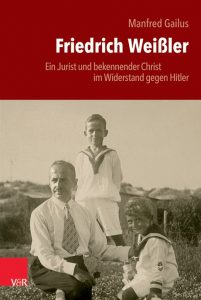 Friedrich Weißler is another such figure. A legal advisor to the Confessing Church, he is usually mentioned (if at all) in his connection to the 1936 Confessing Church memorandum (Denkschrift) to Adolf Hitler. Tortured and beaten to death in Sachsenhausen in February 1937, Weißler was the only person to be killed as a result of the memorandum. Not coincidentally, he was also the only “Volljude” involved. This 2017 book by Manfred Gailus is a gripping biography of a courageous man and a well-documented account of the genesis and aftermath of the memorandum. (Gailus is the first author to examine the papers that were in the family possession.)
Friedrich Weißler is another such figure. A legal advisor to the Confessing Church, he is usually mentioned (if at all) in his connection to the 1936 Confessing Church memorandum (Denkschrift) to Adolf Hitler. Tortured and beaten to death in Sachsenhausen in February 1937, Weißler was the only person to be killed as a result of the memorandum. Not coincidentally, he was also the only “Volljude” involved. This 2017 book by Manfred Gailus is a gripping biography of a courageous man and a well-documented account of the genesis and aftermath of the memorandum. (Gailus is the first author to examine the papers that were in the family possession.) Rebecca Scherf’s study of the German Evangelical Church’s (GEC) responses to the concentration camps is a significant new contribution to the scholarship. While her main focus concerns Protestant clergy who were sent to concentration camps (she confined her study to concentration camps, so it does not include pastors who were in prisons), she has broadened her analysis to address three points of intersection between the GEC and the concentration camp system. The first concerns the relationship between regional churches and the Protestant chaplains who served in the early camps. The second examines the official church responses when clergy were sent to camps. The third looks at the experiences of those who were imprisoned in camps by drawing on contemporary documentation and subsequent memoirs. There are several appendixes with helpful graphs illustrating the number of clergy arrests by year (1935—when there were mass arrests of Confessing pastors due to a pulpit protest—was the peak), by camp, and by regional church. While most clergy who were sent to camps were held only briefly (indicating that the Nazi state intended such arrests as a form of intimidation), the number of arrests during the war grew and fewer were released. There is also a chronologically and geographically organized list of the Protestant clergy who were imprisoned.
Rebecca Scherf’s study of the German Evangelical Church’s (GEC) responses to the concentration camps is a significant new contribution to the scholarship. While her main focus concerns Protestant clergy who were sent to concentration camps (she confined her study to concentration camps, so it does not include pastors who were in prisons), she has broadened her analysis to address three points of intersection between the GEC and the concentration camp system. The first concerns the relationship between regional churches and the Protestant chaplains who served in the early camps. The second examines the official church responses when clergy were sent to camps. The third looks at the experiences of those who were imprisoned in camps by drawing on contemporary documentation and subsequent memoirs. There are several appendixes with helpful graphs illustrating the number of clergy arrests by year (1935—when there were mass arrests of Confessing pastors due to a pulpit protest—was the peak), by camp, and by regional church. While most clergy who were sent to camps were held only briefly (indicating that the Nazi state intended such arrests as a form of intimidation), the number of arrests during the war grew and fewer were released. There is also a chronologically and geographically organized list of the Protestant clergy who were imprisoned.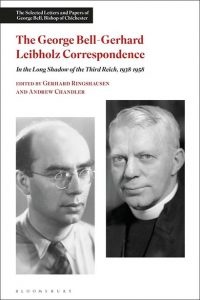 The volume opens with Bell’s September 1938 letter to Bonhoeffer assuring him of his willingness to help the Leibholzes. George Bell had been actively involved since 1933 in assisting refugees from Nazi Germany, including members of the Confessing Church who were affected by the Nazi laws. The early correspondence offers a detailed picture of the difficulties refugees faced even after they reached a safe country. They could not assume, of course, that they would remain in safety; Leibholz’s brother Hans and his wife managed to reach Holland, but committed suicide in 1940 after the German invasion. Added to this anxiety were financial concerns (Germany froze Leibholz’s assets when he fled, so they arrived in England with nothing), worries about the family they had left behind, existential concerns about employment and the future, and dealing with anti-German prejudice in England once the war began. In May 1940 Leibholz was interned as an “enemy alien” on the Isle of Man, along with a number of Confessing Church pastors and their wives. Bell managed to obtain his release in August 1940, after which the two men pursued the possibility that the Leibholzes might immigrate to the United States. With the assistance of Dietrich Bonhoeffer’s contacts in New York, Leibholz was offered and accepted an invitation to Union Theological Seminary in 1941, but by then the door had closed due to new U.S. restrictions on immigration.
The volume opens with Bell’s September 1938 letter to Bonhoeffer assuring him of his willingness to help the Leibholzes. George Bell had been actively involved since 1933 in assisting refugees from Nazi Germany, including members of the Confessing Church who were affected by the Nazi laws. The early correspondence offers a detailed picture of the difficulties refugees faced even after they reached a safe country. They could not assume, of course, that they would remain in safety; Leibholz’s brother Hans and his wife managed to reach Holland, but committed suicide in 1940 after the German invasion. Added to this anxiety were financial concerns (Germany froze Leibholz’s assets when he fled, so they arrived in England with nothing), worries about the family they had left behind, existential concerns about employment and the future, and dealing with anti-German prejudice in England once the war began. In May 1940 Leibholz was interned as an “enemy alien” on the Isle of Man, along with a number of Confessing Church pastors and their wives. Bell managed to obtain his release in August 1940, after which the two men pursued the possibility that the Leibholzes might immigrate to the United States. With the assistance of Dietrich Bonhoeffer’s contacts in New York, Leibholz was offered and accepted an invitation to Union Theological Seminary in 1941, but by then the door had closed due to new U.S. restrictions on immigration.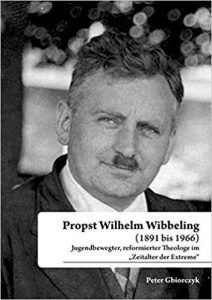 Wibbeling had just completed his theological examinations and practical training for the ministry when the First World War began. He fought, eventually becoming an officer, married shortly after the war ended, and was ordained in 1919. His subsequent career showed his lifelong commitment to the renewal and stability of his church as well as his own strong social-political convictions. His political leanings were socialist. He began his ministry as a youth pastor in the coal-mining town of Bochum in the Ruhr valley, where he reached out to working class, Catholic, socialist, and other youth organizations in the region, creating a coalition that focused especially on the problems of alcoholism among youth. A non-church colleague described him in those years as someone “who didn’t act like a pastor at all, avoided church language and was familiar with and understood the socialist movement.”
Wibbeling had just completed his theological examinations and practical training for the ministry when the First World War began. He fought, eventually becoming an officer, married shortly after the war ended, and was ordained in 1919. His subsequent career showed his lifelong commitment to the renewal and stability of his church as well as his own strong social-political convictions. His political leanings were socialist. He began his ministry as a youth pastor in the coal-mining town of Bochum in the Ruhr valley, where he reached out to working class, Catholic, socialist, and other youth organizations in the region, creating a coalition that focused especially on the problems of alcoholism among youth. A non-church colleague described him in those years as someone “who didn’t act like a pastor at all, avoided church language and was familiar with and understood the socialist movement.”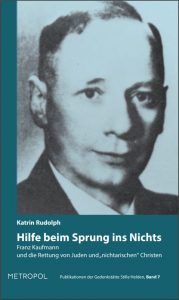 As Rudolph notes in her introduction, however, recent research has yielded new information about the group and important corrections to the earlier accounts (including those in my book), revealing a number of connections between Kaufmann and other people in Berlin who were attempting to help Jews. These findings have altered her understanding of how the Kaufmann group operated, and in this new edition she argues that there was not a distinct and independently operating “Kaufmann circle” but rather a wider network of “small alliances of helpers” who were loosely connected to Franz Kaufmann. This study therefore broadens our view of the group’s activities beyond the immediate circle around Kaufmann and explores the wider dynamics and patterns of assistance to Jews in wartime Berlin. Rudolph has also examined and corrected discrepancies in some of the postwar accounts, and her book serves as a critical study of how postwar narratives about rescue emerged.
As Rudolph notes in her introduction, however, recent research has yielded new information about the group and important corrections to the earlier accounts (including those in my book), revealing a number of connections between Kaufmann and other people in Berlin who were attempting to help Jews. These findings have altered her understanding of how the Kaufmann group operated, and in this new edition she argues that there was not a distinct and independently operating “Kaufmann circle” but rather a wider network of “small alliances of helpers” who were loosely connected to Franz Kaufmann. This study therefore broadens our view of the group’s activities beyond the immediate circle around Kaufmann and explores the wider dynamics and patterns of assistance to Jews in wartime Berlin. Rudolph has also examined and corrected discrepancies in some of the postwar accounts, and her book serves as a critical study of how postwar narratives about rescue emerged. Marianne Jehle-Wildberger’s biography of the Swiss Reformed pastor Adolf Keller traces the life and times of an ecumenical pioneer. Born in 1872, Adolf Keller served churches in Geneva and Zurich as well as the Protestant congregation in Cairo. During the 1920s he became active in the ecumenical movement and was elected second associate general secretary of the Universal Christian Conference on Life and Work at its founding meeting in 1925. In 1922 he founded Inter-Church Aid, an ecumenical relief agency that focused on rebuilding and assisting Protestant communities across Europe in the wake of the First World War. His work was concentrated on the plight of Protestant and Orthodox minorities in Eastern Europe, and the chapter on the interwar situation of these communities in Poland, the Baltic states, Austria, and elsewhere is fascinating. The after-effects of the war included widespread poverty, resurgent nationalisms, shifting church boundaries, and growing political and social instability that posed a vital threat to some of the Protestant minority churches. Keller ambitiously viewed his task as raising international Protestant awareness and “promoting Protestant unification,” and he became a driving force in organizing the different denominational agencies that emerged to assist their partner churches in Europe. He also became a remarkably good fundraiser, raising 1.7 million Swiss francs from U.S. and European churches for his work by 1924.
Marianne Jehle-Wildberger’s biography of the Swiss Reformed pastor Adolf Keller traces the life and times of an ecumenical pioneer. Born in 1872, Adolf Keller served churches in Geneva and Zurich as well as the Protestant congregation in Cairo. During the 1920s he became active in the ecumenical movement and was elected second associate general secretary of the Universal Christian Conference on Life and Work at its founding meeting in 1925. In 1922 he founded Inter-Church Aid, an ecumenical relief agency that focused on rebuilding and assisting Protestant communities across Europe in the wake of the First World War. His work was concentrated on the plight of Protestant and Orthodox minorities in Eastern Europe, and the chapter on the interwar situation of these communities in Poland, the Baltic states, Austria, and elsewhere is fascinating. The after-effects of the war included widespread poverty, resurgent nationalisms, shifting church boundaries, and growing political and social instability that posed a vital threat to some of the Protestant minority churches. Keller ambitiously viewed his task as raising international Protestant awareness and “promoting Protestant unification,” and he became a driving force in organizing the different denominational agencies that emerged to assist their partner churches in Europe. He also became a remarkably good fundraiser, raising 1.7 million Swiss francs from U.S. and European churches for his work by 1924. Heinrich Rusterholz’s book on the work of the Swiss Protestant Relief Agency (Hilfswerk) for the Confessing Church covers some of the same territory (and naturally includes additional documentation on Keller’s work), but focuses on the Swiss Reformed circles and their responses to the German Church Struggle and the persecution of the Jews. Paul Vogt, the leader of many of these initiatives, is another under-examined figure in the history. Born in 1900, he began his career in 1929, focusing in his ministry on unemployment and other working class issues. He founded a social ministry center, “Sonneblick,” that became a refugee haven in the mid-1930s. From 1936-43 he was a pastor in a suburb of Zurich. He also began to work closely with Karl Barth, and the two founded the Hilfswerk in 1937 in solidarity with the German Confessing Church; one of their first actions was to organize statements of support for imprisoned Martin Niemoeller. The organization also began to offer seminars in Switzerland for lay and clergy from the Confessing Church.
Heinrich Rusterholz’s book on the work of the Swiss Protestant Relief Agency (Hilfswerk) for the Confessing Church covers some of the same territory (and naturally includes additional documentation on Keller’s work), but focuses on the Swiss Reformed circles and their responses to the German Church Struggle and the persecution of the Jews. Paul Vogt, the leader of many of these initiatives, is another under-examined figure in the history. Born in 1900, he began his career in 1929, focusing in his ministry on unemployment and other working class issues. He founded a social ministry center, “Sonneblick,” that became a refugee haven in the mid-1930s. From 1936-43 he was a pastor in a suburb of Zurich. He also began to work closely with Karl Barth, and the two founded the Hilfswerk in 1937 in solidarity with the German Confessing Church; one of their first actions was to organize statements of support for imprisoned Martin Niemoeller. The organization also began to offer seminars in Switzerland for lay and clergy from the Confessing Church.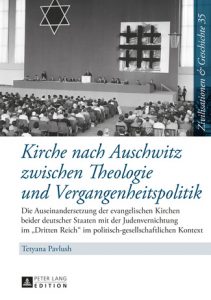 Pavlush focuses primarily on four events: the 1961 trial of Adolf Eichmann and the wave of antisemitism that swept Germany around the same time; the controversy about Rolf Hochhuth’s 1963 play Der Stellvertreter (The Deputy); the 1967 Six-Day War; and the 1979 national broadcast in the FRG of the U.S. television docudrama The Holocaust. In a separate chapter she examines the 1968, 1978, and 1988 anniversaries of the November 9 pogroms (“Kristallnacht”) as indicators of how East and West Germans viewed their history.
Pavlush focuses primarily on four events: the 1961 trial of Adolf Eichmann and the wave of antisemitism that swept Germany around the same time; the controversy about Rolf Hochhuth’s 1963 play Der Stellvertreter (The Deputy); the 1967 Six-Day War; and the 1979 national broadcast in the FRG of the U.S. television docudrama The Holocaust. In a separate chapter she examines the 1968, 1978, and 1988 anniversaries of the November 9 pogroms (“Kristallnacht”) as indicators of how East and West Germans viewed their history.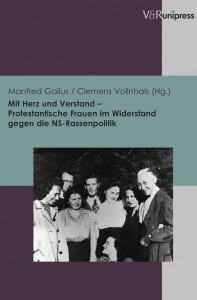 Mit Herz und Verstand is one of his recent additions to the literature. In addition to the fine overview of the topic in the introduction by Gailus and co-editor Clemens Vollnhals, it consists of biographical and historical profiles of Agnes and Elisabet von Harnack, Elisabeth Abegg, Elisabeth Schmitz, Elisabeth Schiemann, Margarete Meusel, Katharina Staritz, Agnes Wendland and her daughters Ruth and Angelika, Helene Jacobs, Sophie Benfey-Kunert, Elisabeth von Thadden, and Ina Gschlössl.
Mit Herz und Verstand is one of his recent additions to the literature. In addition to the fine overview of the topic in the introduction by Gailus and co-editor Clemens Vollnhals, it consists of biographical and historical profiles of Agnes and Elisabet von Harnack, Elisabeth Abegg, Elisabeth Schmitz, Elisabeth Schiemann, Margarete Meusel, Katharina Staritz, Agnes Wendland and her daughters Ruth and Angelika, Helene Jacobs, Sophie Benfey-Kunert, Elisabeth von Thadden, and Ina Gschlössl.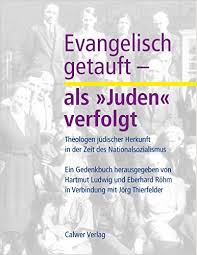 Evangelisch getauft—als “Juden” verfolgt is not a comprehensive history of this topic; nonetheless it is a valuable contribution to the literature. As its subtitle indicates, it is primarily a Gedenkbuch with brief biographies of 180 German Protestants whose lives were changed by the racial laws and the responses of their church. The editors have cast a wide net. The individuals profiled here include not only theologians and members of the Christian clergy, but individuals who were barred from studying theology before 1945 and others who, barred from other professions, decided to study theology in exile. Also included are teachers of religious education, Christians in “mixed” marriages, Austrians who came under Nazi law after 1938, and even several individuals who were Deutsche Christen or members of the Nazi party. While most of those profiled were members of the German Evangelical Church, there are also several profiles of individuals from Methodist, Baptist, and other free churches.
Evangelisch getauft—als “Juden” verfolgt is not a comprehensive history of this topic; nonetheless it is a valuable contribution to the literature. As its subtitle indicates, it is primarily a Gedenkbuch with brief biographies of 180 German Protestants whose lives were changed by the racial laws and the responses of their church. The editors have cast a wide net. The individuals profiled here include not only theologians and members of the Christian clergy, but individuals who were barred from studying theology before 1945 and others who, barred from other professions, decided to study theology in exile. Also included are teachers of religious education, Christians in “mixed” marriages, Austrians who came under Nazi law after 1938, and even several individuals who were Deutsche Christen or members of the Nazi party. While most of those profiled were members of the German Evangelical Church, there are also several profiles of individuals from Methodist, Baptist, and other free churches.